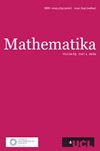求助PDF
{"title":"置换与[1,n]的除数图","authors":"Nathan McNew","doi":"10.1112/mtk.12177","DOIUrl":null,"url":null,"abstract":"<p>Let <math>\n <semantics>\n <mrow>\n <msub>\n <mi>S</mi>\n <mi>div</mi>\n </msub>\n <mrow>\n <mo>(</mo>\n <mi>n</mi>\n <mo>)</mo>\n </mrow>\n </mrow>\n <annotation>$S_{\\rm div}(n)$</annotation>\n </semantics></math> denote the set of permutations π of <i>n</i> such that for each <math>\n <semantics>\n <mrow>\n <mn>1</mn>\n <mo>⩽</mo>\n <mi>j</mi>\n <mo>⩽</mo>\n <mi>n</mi>\n </mrow>\n <annotation>$1\\leqslant j \\leqslant n$</annotation>\n </semantics></math> either <math>\n <semantics>\n <mrow>\n <mi>j</mi>\n <mo>∣</mo>\n <mi>π</mi>\n <mo>(</mo>\n <mi>j</mi>\n <mo>)</mo>\n </mrow>\n <annotation>$j \\mid \\pi (j)$</annotation>\n </semantics></math> or <math>\n <semantics>\n <mrow>\n <mi>π</mi>\n <mo>(</mo>\n <mi>j</mi>\n <mo>)</mo>\n <mo>∣</mo>\n <mi>j</mi>\n </mrow>\n <annotation>$\\pi (j) \\mid j$</annotation>\n </semantics></math>. These permutations can also be viewed as vertex-disjoint directed cycle covers of the divisor graph <math>\n <semantics>\n <msub>\n <mi>D</mi>\n <mrow>\n <mo>[</mo>\n <mn>1</mn>\n <mo>,</mo>\n <mi>n</mi>\n <mo>]</mo>\n </mrow>\n </msub>\n <annotation>$\\mathcal {D}_{[1,n]}$</annotation>\n </semantics></math> on vertices <math>\n <semantics>\n <mrow>\n <msub>\n <mi>v</mi>\n <mn>1</mn>\n </msub>\n <mo>,</mo>\n <mtext>…</mtext>\n <mo>,</mo>\n <msub>\n <mi>v</mi>\n <mi>n</mi>\n </msub>\n </mrow>\n <annotation>$v_1, \\ldots , v_n$</annotation>\n </semantics></math> with an edge between <math>\n <semantics>\n <msub>\n <mi>v</mi>\n <mi>i</mi>\n </msub>\n <annotation>$v_i$</annotation>\n </semantics></math> and <math>\n <semantics>\n <msub>\n <mi>v</mi>\n <mi>j</mi>\n </msub>\n <annotation>$v_j$</annotation>\n </semantics></math> if <math>\n <semantics>\n <mrow>\n <mi>i</mi>\n <mo>∣</mo>\n <mi>j</mi>\n </mrow>\n <annotation>$i\\mid j$</annotation>\n </semantics></math> or <math>\n <semantics>\n <mrow>\n <mi>j</mi>\n <mo>∣</mo>\n <mi>i</mi>\n </mrow>\n <annotation>$j \\mid i$</annotation>\n </semantics></math>. We improve on recent results of Pomerance by showing <math>\n <semantics>\n <mrow>\n <msub>\n <mi>c</mi>\n <mi>d</mi>\n </msub>\n <mo>=</mo>\n <msub>\n <mi>lim</mi>\n <mrow>\n <mi>n</mi>\n <mo>→</mo>\n <mi>∞</mi>\n </mrow>\n </msub>\n <msup>\n <mrow>\n <mo>(</mo>\n <mo>#</mo>\n <msub>\n <mi>S</mi>\n <mi>div</mi>\n </msub>\n <mrow>\n <mo>(</mo>\n <mi>n</mi>\n <mo>)</mo>\n </mrow>\n <mo>)</mo>\n </mrow>\n <mrow>\n <mn>1</mn>\n <mo>/</mo>\n <mi>n</mi>\n </mrow>\n </msup>\n </mrow>\n <annotation>$c_d = \\lim _{n \\rightarrow \\infty }(\\# S_{\\rm div}(n))^{1/n}$</annotation>\n </semantics></math> exists and that <math>\n <semantics>\n <mrow>\n <mn>2.069</mn>\n <mo><</mo>\n <msub>\n <mi>c</mi>\n <mi>d</mi>\n </msub>\n <mo><</mo>\n <mn>2.694</mn>\n </mrow>\n <annotation>$2.069<c_d<2.694$</annotation>\n </semantics></math>. We also obtain similar results for the set <math>\n <semantics>\n <mrow>\n <msub>\n <mi>S</mi>\n <mi>lcm</mi>\n </msub>\n <mrow>\n <mo>(</mo>\n <mi>n</mi>\n <mo>)</mo>\n </mrow>\n </mrow>\n <annotation>$S_{\\rm lcm}(n)$</annotation>\n </semantics></math> of permutations where <math>\n <semantics>\n <mrow>\n <mo>lcm</mo>\n <mo>(</mo>\n <mi>j</mi>\n <mo>,</mo>\n <mi>π</mi>\n <mo>(</mo>\n <mi>j</mi>\n <mo>)</mo>\n <mo>)</mo>\n <mo>⩽</mo>\n <mi>n</mi>\n </mrow>\n <annotation>$\\operatorname{lcm}(j,\\pi (j))\\leqslant n$</annotation>\n </semantics></math> for all <i>j</i>. The results rely on a graph theoretic result bounding the number of vertex-disjoint directed cycle covers, which may be of independent interest.</p>","PeriodicalId":18463,"journal":{"name":"Mathematika","volume":"69 1","pages":"51-67"},"PeriodicalIF":0.8000,"publicationDate":"2022-12-02","publicationTypes":"Journal Article","fieldsOfStudy":null,"isOpenAccess":false,"openAccessPdf":"","citationCount":"0","resultStr":"{\"title\":\"Permutations and the divisor graph of [1, n]\",\"authors\":\"Nathan McNew\",\"doi\":\"10.1112/mtk.12177\",\"DOIUrl\":null,\"url\":null,\"abstract\":\"<p>Let <math>\\n <semantics>\\n <mrow>\\n <msub>\\n <mi>S</mi>\\n <mi>div</mi>\\n </msub>\\n <mrow>\\n <mo>(</mo>\\n <mi>n</mi>\\n <mo>)</mo>\\n </mrow>\\n </mrow>\\n <annotation>$S_{\\\\rm div}(n)$</annotation>\\n </semantics></math> denote the set of permutations π of <i>n</i> such that for each <math>\\n <semantics>\\n <mrow>\\n <mn>1</mn>\\n <mo>⩽</mo>\\n <mi>j</mi>\\n <mo>⩽</mo>\\n <mi>n</mi>\\n </mrow>\\n <annotation>$1\\\\leqslant j \\\\leqslant n$</annotation>\\n </semantics></math> either <math>\\n <semantics>\\n <mrow>\\n <mi>j</mi>\\n <mo>∣</mo>\\n <mi>π</mi>\\n <mo>(</mo>\\n <mi>j</mi>\\n <mo>)</mo>\\n </mrow>\\n <annotation>$j \\\\mid \\\\pi (j)$</annotation>\\n </semantics></math> or <math>\\n <semantics>\\n <mrow>\\n <mi>π</mi>\\n <mo>(</mo>\\n <mi>j</mi>\\n <mo>)</mo>\\n <mo>∣</mo>\\n <mi>j</mi>\\n </mrow>\\n <annotation>$\\\\pi (j) \\\\mid j$</annotation>\\n </semantics></math>. These permutations can also be viewed as vertex-disjoint directed cycle covers of the divisor graph <math>\\n <semantics>\\n <msub>\\n <mi>D</mi>\\n <mrow>\\n <mo>[</mo>\\n <mn>1</mn>\\n <mo>,</mo>\\n <mi>n</mi>\\n <mo>]</mo>\\n </mrow>\\n </msub>\\n <annotation>$\\\\mathcal {D}_{[1,n]}$</annotation>\\n </semantics></math> on vertices <math>\\n <semantics>\\n <mrow>\\n <msub>\\n <mi>v</mi>\\n <mn>1</mn>\\n </msub>\\n <mo>,</mo>\\n <mtext>…</mtext>\\n <mo>,</mo>\\n <msub>\\n <mi>v</mi>\\n <mi>n</mi>\\n </msub>\\n </mrow>\\n <annotation>$v_1, \\\\ldots , v_n$</annotation>\\n </semantics></math> with an edge between <math>\\n <semantics>\\n <msub>\\n <mi>v</mi>\\n <mi>i</mi>\\n </msub>\\n <annotation>$v_i$</annotation>\\n </semantics></math> and <math>\\n <semantics>\\n <msub>\\n <mi>v</mi>\\n <mi>j</mi>\\n </msub>\\n <annotation>$v_j$</annotation>\\n </semantics></math> if <math>\\n <semantics>\\n <mrow>\\n <mi>i</mi>\\n <mo>∣</mo>\\n <mi>j</mi>\\n </mrow>\\n <annotation>$i\\\\mid j$</annotation>\\n </semantics></math> or <math>\\n <semantics>\\n <mrow>\\n <mi>j</mi>\\n <mo>∣</mo>\\n <mi>i</mi>\\n </mrow>\\n <annotation>$j \\\\mid i$</annotation>\\n </semantics></math>. We improve on recent results of Pomerance by showing <math>\\n <semantics>\\n <mrow>\\n <msub>\\n <mi>c</mi>\\n <mi>d</mi>\\n </msub>\\n <mo>=</mo>\\n <msub>\\n <mi>lim</mi>\\n <mrow>\\n <mi>n</mi>\\n <mo>→</mo>\\n <mi>∞</mi>\\n </mrow>\\n </msub>\\n <msup>\\n <mrow>\\n <mo>(</mo>\\n <mo>#</mo>\\n <msub>\\n <mi>S</mi>\\n <mi>div</mi>\\n </msub>\\n <mrow>\\n <mo>(</mo>\\n <mi>n</mi>\\n <mo>)</mo>\\n </mrow>\\n <mo>)</mo>\\n </mrow>\\n <mrow>\\n <mn>1</mn>\\n <mo>/</mo>\\n <mi>n</mi>\\n </mrow>\\n </msup>\\n </mrow>\\n <annotation>$c_d = \\\\lim _{n \\\\rightarrow \\\\infty }(\\\\# S_{\\\\rm div}(n))^{1/n}$</annotation>\\n </semantics></math> exists and that <math>\\n <semantics>\\n <mrow>\\n <mn>2.069</mn>\\n <mo><</mo>\\n <msub>\\n <mi>c</mi>\\n <mi>d</mi>\\n </msub>\\n <mo><</mo>\\n <mn>2.694</mn>\\n </mrow>\\n <annotation>$2.069<c_d<2.694$</annotation>\\n </semantics></math>. We also obtain similar results for the set <math>\\n <semantics>\\n <mrow>\\n <msub>\\n <mi>S</mi>\\n <mi>lcm</mi>\\n </msub>\\n <mrow>\\n <mo>(</mo>\\n <mi>n</mi>\\n <mo>)</mo>\\n </mrow>\\n </mrow>\\n <annotation>$S_{\\\\rm lcm}(n)$</annotation>\\n </semantics></math> of permutations where <math>\\n <semantics>\\n <mrow>\\n <mo>lcm</mo>\\n <mo>(</mo>\\n <mi>j</mi>\\n <mo>,</mo>\\n <mi>π</mi>\\n <mo>(</mo>\\n <mi>j</mi>\\n <mo>)</mo>\\n <mo>)</mo>\\n <mo>⩽</mo>\\n <mi>n</mi>\\n </mrow>\\n <annotation>$\\\\operatorname{lcm}(j,\\\\pi (j))\\\\leqslant n$</annotation>\\n </semantics></math> for all <i>j</i>. The results rely on a graph theoretic result bounding the number of vertex-disjoint directed cycle covers, which may be of independent interest.</p>\",\"PeriodicalId\":18463,\"journal\":{\"name\":\"Mathematika\",\"volume\":\"69 1\",\"pages\":\"51-67\"},\"PeriodicalIF\":0.8000,\"publicationDate\":\"2022-12-02\",\"publicationTypes\":\"Journal Article\",\"fieldsOfStudy\":null,\"isOpenAccess\":false,\"openAccessPdf\":\"\",\"citationCount\":\"0\",\"resultStr\":null,\"platform\":\"Semanticscholar\",\"paperid\":null,\"PeriodicalName\":\"Mathematika\",\"FirstCategoryId\":\"100\",\"ListUrlMain\":\"https://onlinelibrary.wiley.com/doi/10.1112/mtk.12177\",\"RegionNum\":3,\"RegionCategory\":\"数学\",\"ArticlePicture\":[],\"TitleCN\":null,\"AbstractTextCN\":null,\"PMCID\":null,\"EPubDate\":\"\",\"PubModel\":\"\",\"JCR\":\"Q2\",\"JCRName\":\"MATHEMATICS\",\"Score\":null,\"Total\":0}","platform":"Semanticscholar","paperid":null,"PeriodicalName":"Mathematika","FirstCategoryId":"100","ListUrlMain":"https://onlinelibrary.wiley.com/doi/10.1112/mtk.12177","RegionNum":3,"RegionCategory":"数学","ArticlePicture":[],"TitleCN":null,"AbstractTextCN":null,"PMCID":null,"EPubDate":"","PubModel":"","JCR":"Q2","JCRName":"MATHEMATICS","Score":null,"Total":0}
引用次数: 0
引用
批量引用

 求助内容:
求助内容: 应助结果提醒方式:
应助结果提醒方式:


